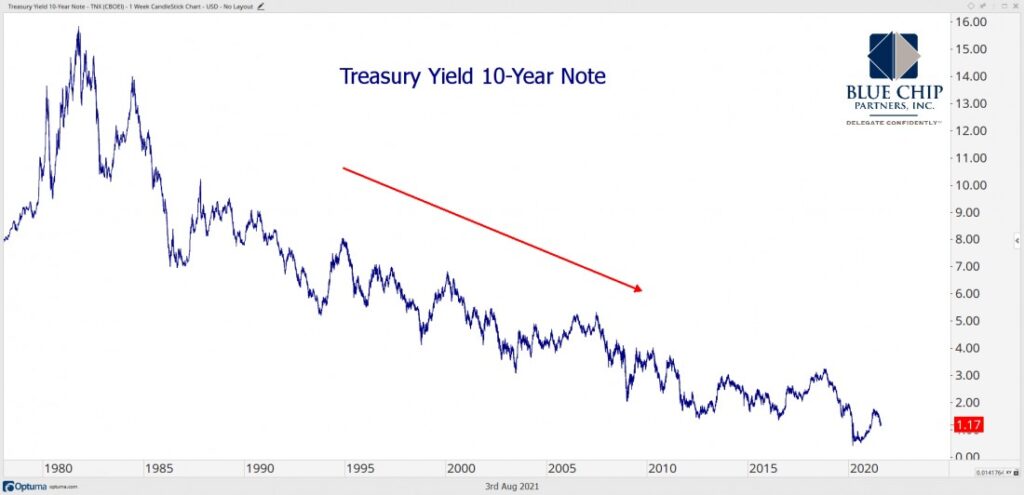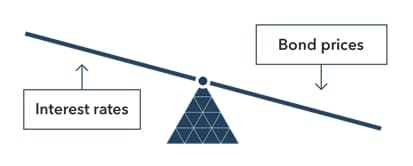Bonds have historically provided great returns. Interest rates in the United States have been steadily falling since the early 1980s. Yes, that’s right, we have been in what is considered a 40-year bull market run in fixed income (i.e. bonds). This rally in bonds started when interest rates peaked in September 1981. Was March 2021 the official low, shifting us to a bear market?
There isn’t enough evidence to say the bull market is over.
The key interest rate to consider is the United States 10-year Treasury, which set a new low in yield back in March 2020 at just above 0.50%. Time will tell, but we may very well look back on the pandemic as the catalyst that ultimately ended the 4-decade bull market in bonds.

Bond prices have an inverse relationship to interest rates. As interest rates go lower, bond prices go up and if interest rates head higher, bond prices go down. Increasing bond prices means better performance of the asset class. If the benefit of a falling interest rate environment has subsided, it’s helpful to understand the dynamics that will drive bond performance into the future and the impact that could be felt in a portfolio.

As of writing this, the U.S. 10-year Treasury bond is hovering right about 1.20%. So, if you bought this bond today, the yield to maturity would be a rate of 1.2% per year until you ultimately received the principle back on the bond at maturity. To do better than 1.2% per year, you would need interest rates to drop from 1.2% to something lower for the bond price to increase.
Bonds tend to underperform in periods of rising inflation.
The performance picture worsens when you factor in inflation – which has received a fair amount of press in 2021. In a period of stagnating bond yields and stable bond prices, inflation acts as an additional tax, robbing an investor of “purchasing power.”
Consider a hypothetical example:
A bond will pay an investor 3.0% interest over the next year and inflation is being measured at 2.0%. That bond’s inflation-adjusted return is only 1.0%.
This is NOT a call to sell all bond holdings. There are many reasons bonds are an integral part of a portfolio’s allocation, like mitigating stock market volatility. However, we must acknowledge that the last four decades of falling interest rates will likely not provide the same tailwind for bonds moving forward (let alone the next four decades).
Now is a good time to check your bond allocation. The classic 60/40 investment portfolio may not get you to your financial goals. The risks of being too heavily weighted in bonds are not always transparent. While bonds may not be as susceptible to the swings in stocks, the interest rate environment should not be ignored.
Interest Rate Environment Scenarios
- Interest rates increase:
A direct headwind to bond prices and returns - Interest rates remain stable or decline:
Bonds will yield minimal interest – barely paying enough to keep up with inflation
In either scenario, bonds may pose a serious dilemma for investors if the bull market in bonds is truly over. This threat is not always transparent, particularly for those using Target Date Funds in a company retirement plan, such as a 401(k). Investors who are over-allocated to bonds in fear of stock market volatility must ask themselves, “which asset class carries more risk going forward?”
Expressions of opinion are as of this date and are subject to change without notice. The information provided does not constitute tax, legal, accounting, or other professional advice and is without warranty as to the accuracy or completeness of the information. Any information provided is not a complete summary or statement of all available data necessary for making an investment decision and does not constitute a recommendation to buy, hold or sell any security. The information has been obtained from sources considered to be reliable, but we do not guarantee that the foregoing material is accurate or complete. There are limitations associated with the use of any method of securities analysis. Indices are included for informational purposes only; investors cannot invest directly in any index. Every investor’s situation is unique, and you should consider your investment goals, risk tolerance and time horizon before making any investment. Prior to making an investment decision, please consult with your financial advisor about your individual situation. Past performance does not guarantee future results. Investing involves risk and you may incur a profit or loss regardless of strategy selected. There is no guarantee that any statements, opinions or forecasts provided herein will prove to be correct.

